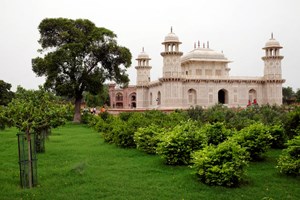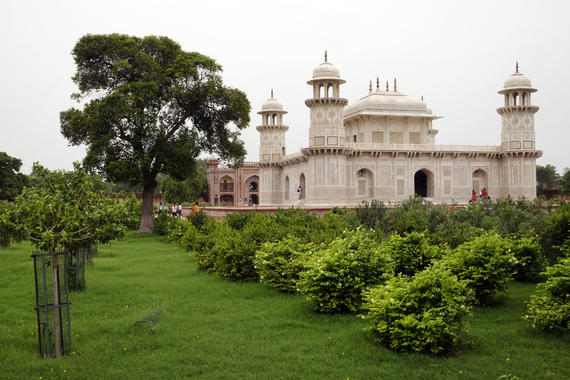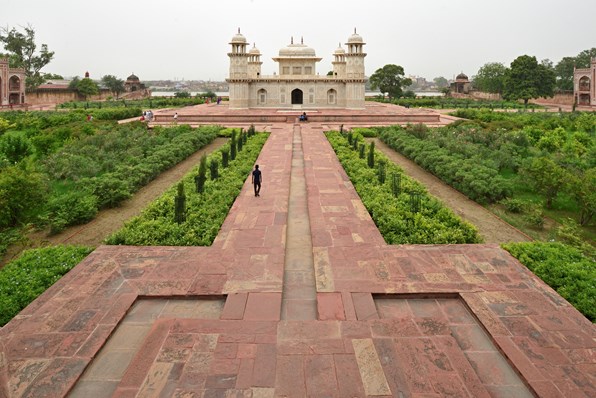
The scent of jasmine. Oleander blooms in various shades of pink. Butterflies hovering over flowering hibiscus. These are the sights and smells you encounter today at the Mughal Gardens in Agra, India–just as they were experienced in the sixteenth and seventeenth centuries. But it wasn’t always the case.
Image: Mughal Gardens in Agra, India, copyright World Monuments Fund
The scent of jasmine. Oleander blooms in various shades of pink. Butterflies hovering over flowering hibiscus. These are the sights and smells you encounter today at the Mughal Gardens in Agra, India–just as they were experienced in the sixteenth and seventeenth centuries. But it wasn’t always the case.
The Yamuna riverfront in Agra was once enclosed by high-walled gardens, mansions, and pavilions that served as sanctuaries for royalty and nobility from the city’s heat and dust. Later, some became funerary gardens, venerating Agra’s deceased. Today, only a few of the original 44 gardens survive intact. Others have been significantly altered and eroded over time.

Mughal Gardens in Agra, India, copyright World Monuments Fund
Four years ago, World Monuments Fund embarked on a rigorous conservation project in partnership with the Archaeological Survey of India at two of Agra’s most celebrated gardens—Mehtab Bagh, and the Garden of the Tomb of I’timad-ud-Daulah—aiming to restore them to their authentic form, re-activate their water features, and enhance visitor experience. Never before had the restoration of an entire garden been attempted at these sites. It soon became clear that one thing would be central to their success: water.
“There is no doubt that the Yamuna river, which was once irrigated with melting Himalayan snow, was the lifeline of the gardens in the seventeenth century,” said Annabel Lopez, project coordinator at the Mughal Gardens. “In comparison, the polluted trickle that we are left with today is more harmful than good.”
The challenge required an innovative approach, fusing the original and existing water systems and installing a water treatment system. The resulting integrated water solution optimizes existing water resources—including all of the water available within the site— without impacting neighboring areas. This spring, clean water again flowed through the gardens for the first time in centuries.
Extensive research was also used to identify original plant species and reestablish a grid for planting. The introduction of spacious lawns some 100 years ago made the strategy more difficult. But within only a few short years, pomegranates were growing on the trees and floral fragrance filled the air. As the gardens develop, Amita Baig, WMF’s representative in India, hopes they will become an oasis in the overcrowded city. “To enter this very secluded site and hear the sound of water flowing, to smell the fragrance of a flower and see it bear fruit in different seasons, will be magical.”

Mughal Gardens in Agra, India, copyright World Monuments Fund
The project will finish with the completion of a visitor center at I’timad-ud-Daulah, to open in 2019. Raising awareness and visibility of the gardens that are often overshadowed by their more famous neighbor, the Taj Mahal, was an important objective of the conservation. The enhanced visitor services will offer local residents and tourists an opportunity to learn more about the history of the magnificent gardens.
As the project comes to a close, reflecting on the original spirit of the gardens provides even more context for what has been achieved. “The Mughal Gardens have four fundamental prerequisites, four allegorical essentials for the afterlife: shade, fruit, fragrance and running water,” said Baig. “We have accomplished this.”
Courtesy to World Monuments Fund

ArtDependence Magazine is an international magazine covering all spheres of contemporary art, as well as modern and classical art.
ArtDependence features the latest art news, highlighting interviews with today’s most influential artists, galleries, curators, collectors, fair directors and individuals at the axis of the arts.
The magazine also covers series of articles and reviews on critical art events, new publications and other foremost happenings in the art world.
If you would like to submit events or editorial content to ArtDependence Magazine, please feel free to reach the magazine via the contact page.